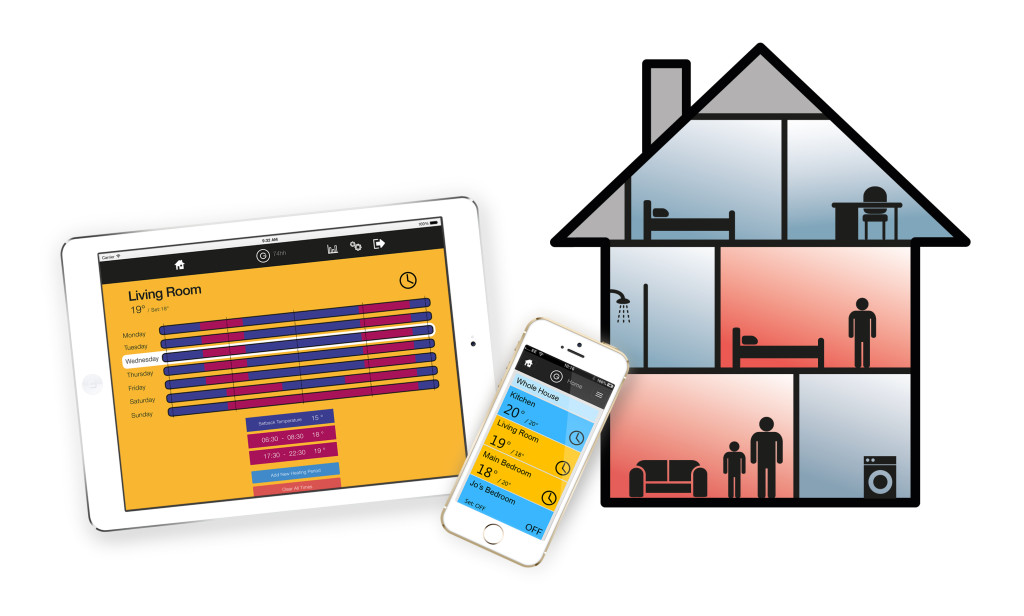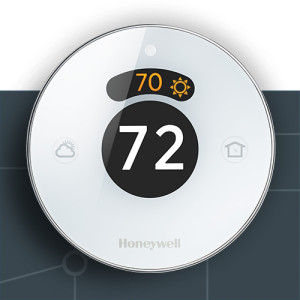
Since writing the original “Looking for a more Intelligent Heating Control System” article earlier this year, we are pleased to say that other manufacturers have now entered the area and their products are worth a review. We have also had numerous amount of interest from the manufacturers themselves to review their intelligent heating systems.
Just as a quick recap – an intelligent heating control system varies to your traditional wall thermostat; some models allow the user remote access via the internet so you can control the heating with your smartphone; others allow zoning so that you can control the temperature of each zone (living room, kitchen, dining room, bathroom, etc) independently and finally some systems like the Heat Genius are able to learn so that they regulate the temperature of the rooms as and when you need them based on your behaviour.
What is the point of intelligent heating control systems?
Aside from the fact that most of the systems here look very suave and they have some fantastic displays and functionalities, the whole point actually should be about matching the heating patterns a lot more accurately to the households requirements so that gas and electricity is not used wastefully.
Obviously the savings you would expect will vary from system to system but the principles are the same, use less fuel while not compromising comfort should help save you money on your energy bills.
We have already covered Hive, Heat Genius, Nest and Honeywell Evohome in a previous article – to get our thoughts on those click on the link below!
>>> Interested in Hive, Tado, Nest or Honeywell Evohome <<<
In the following section we cover various other intelligent heating control systems – from single zone to multi zone systems and summarising each one based on their merits.
The Heat Genius Intelligent heating control system
Last to be considered is the Heat Genius, the smartest of the lot and ‘new kid on the block’!. Speaking to its founder Alasdair Woodbridge at Ecobuild 2014, he explained to us that the Heat Genius takes the learning of the Nest Intelligent Thermostat and marries it with the zonal heating capability of the Honeywell evohome to provide the breadth and depth of functionality to deal with the challenges of heating a modern home.
 The product has three main components including: the Heat Genius hub (which remotely turns your boiler on or off or works with the room thermostat), electronic thermostatic radiator valves, (which slot on the radiators allowing you to control the temperature of each room), and finally the wireless motion sensors (that allows you to control the room temperature in an automated fashion).
The product has three main components including: the Heat Genius hub (which remotely turns your boiler on or off or works with the room thermostat), electronic thermostatic radiator valves, (which slot on the radiators allowing you to control the temperature of each room), and finally the wireless motion sensors (that allows you to control the room temperature in an automated fashion).
The Heat Genius hub is sold for around £249 and is relatively easy to install – although we always recommend you get a professional to do the installation. A separate wireless controller is connected into your boiler, which then talks to the hub box that is plugged into your broadband router.
Typically in each room (or zone – depending on the level of control you want), you will need one wireless motion sensor and an automated TRV for each radiator.
The motion sensors allow you to take that step further in heating management – combining zonal control with the ability for the motion sensors to learn your habits. So, in theory the product will know you don’t require the heating on certain days then adjust to take this into account. You can still have full control of your heating with a manual schedule for each room or you can let the Genius Hub do the hard work and optimise the heating schedule for you.

The current design will allow you to have 50 separate smart TRVs and/ or motion sensors, so in theory there shouldn’t be design issues when trying to get the whole house thermostatically controlled; and on-top of its learning capabilities is our current winner in the battle for the best smart thermostatic controlled system.
Owl
The Owl system has a solution for combi boilers or heat only boilers (with a hot water tank). If you do have a hot water tank you can choose a wired or wireless solution.
The setups are as follows:
- Owl intuition-c – wired set-up for the combi boiler, which slots into your existing thermostat position. If you don’t have a thermostat then you will have to go for the Owl intuition-cw below.
- Owl intuition-cw – wireless set-up or if you don’t already have an existing thermostat wired to your existing heating system.
- Owl intuition-h – heat only boiler and a hot water tank temperature control. Slots onto your existing thermostat, which would be wired to your heating system.
- Owl intuition-hw – wireless set-up and hot water tank temperature control. You would also need this product if you don’t have an existing thermostat wired to your heating system.
In terms of the kit supplied, they all come with a Network Owl, which connects directly to the back of your broadband router (remember the Lyric and Nest talk to the route without the need for this dongle). Depending on the option that you go for this may or may not come with a relay unit. For example the Owl intuition-c and the Owl intuition-h don’t come with one as the room sensor slots into the existing thermostat wiring, which is then already wired back to your boiler. Otherwise the relay unit would be wired to the boiler, then remotely talk to the room sensor/s, if you decide to go for Owl intuition-cw or the Owl intuition-hw.
If you have a hot water tank then you will be able to install the hot water sensor that will relay information straight back to the Network Owl.
Once the system is set-up you will need to have the app installed and set-up, either on the android or apple system. The solution has no free standing temperature gauge (unlike the Nest or the Hive) so you will need to flick back and forth within your app to see this.
The solution has 3 pre-set heating programmes, one of which is a holiday mode that would keep your heating off until you return. You could also manually programme it to coincide with your Monday to Sunday schedule (although this may take a bit of time to get right) or you can simply set it to work off a target temperature.
Unlike the Tado, the Owl can have up to a maximum of 4 zones wired into the system. However despite these options, we can’t see how this is beneficial to a classical radiator wet central heating system because as soon as the pre-set temperature is reached in a zone the gas boiler will in theory turn off, independent of the pre-set temperatures in other zones. It will only work well if you have underfloor heating throughout the property as you can regulate which zones have the heat.
Heatmiser Neo
In order to use the Heatmiser Neo, you need to buy their starter pack, which contains the Neohub and the Neostat. You will require a Neostat for each zone you want to set up – so that would require buying additional Neostats.
Each Neostat (or roomstat!) would need to be wired in, and we suggest getting an electrician to do this, but the Neohub is relatively simple to install yourself. This connects to the back of your router and is in contact with all the Neostats in the zones.
The Heatmiser Neo system allows you to set up 32 different heating control zones in your home which should be plenty unless you live in Buckingham Palace.
The Neohub works with an android or iOS app and allows you to control and monitor your home heating remotely. Obviously, a zonal system does not give you the same levels of control as independent automated TRVs on each radiator, but the simplicity of this system to be honest is one of its strengths.
Insteon
This manufacturer prides itself on a full home automation solution, which means that despite including an intelligent heating system, they also want you to incorporate lots more of their systems.
To get started with the Insteon system, you need to install their Insteon hub, which is the transmitter that plugs into your broadband router – it appears these hubs are central to all these types of intelligent heating controls.
Then you need to decide which part of the home you want to automate, so obviously for us to include it here, they have a wireless thermostat offering, but they also have automated lighting circuits, remotely controlled plugs, motion sensors and all sorts of other home automation systems.
It appears that in offering all these different products, they have neglected to spend a huge amount of time on their thermostat offering, but it can be controlled from the mobile phone app. If you are looking to install a fully intelligent heating control system, we would suggest probably looking elsewhere, but if you want to maximise home automation, then this is a rather elegant solution!
Honeywell Lyric
This latest smart wall thermostat from Honeywell (currently only available in the US – expected to reach the UK in 2015) seems to be firmly based on the Nest system, i.e. single zone intelligent system, with a pretty user interface. It is programmable to work with wet heating systems as well as duct heating and cooling. It is therefore the ‘one-stop-shop’ for your home’s climate control.
Essentially like the Nest it is a single zone thermostat, connects simply to your existing broadband router (assuming router compatibility) and has a pretty easy set-up. It can be wired into the space used by your old thermostat and this can be done by following online instructions or you can call in a specialist engineer to have this installed for you. Once the thermostat is set up you can control the heating on-off times pretty much anywhere around the world at the world at the click of a button.
Like the Tado, it has geofencing capability, which as discussed previously is app based detection system – so when you go to work and are more than 7 miles away from the thermostat location it will realise that you are not at home and simply turn down or off to the pre-set programme.
It has weather detection capabilities, so for example if you are work you may suddenly get a warning message that the weather will freeze up, which will help you make decisions about how you would like to heat your property in the next 24 hours.
If linked to your domestic HVAC system, it will always be adjusting between the heating and cooling devices to give you the desired temperature in the home.
The wall unit itself is pretty easy to use – the temperature can be adjusted at any time; there is a weather button that will give you the forecast and an away button that you can use to turn down the heat when you leave the house. The away button will override the geofencing features if you have them set-up.
How these thermostats stack up on price?
In preparing this article our team has been doing a bit of shopping around for the price of the various units. Here is what we found:
- Heat Genius – costs starting at around £249 but you can soon find yourself paying £500 for a complete system
- Owl – prices start about £150 depending on which of the 4 combinations you are purchasing, right up to £250 if you also have a hot water tank. If you are adding additional room temperature sensors then be prepared to outlay an additional £75 for each one.
- Heatmiser – the Neo kit starts at £199, which includes the Neohub and the Neostat. You can add more stats for the various zones as well as a hot water stat at additional cost.
- Insteon – you can buy a starter pack, which includes the hub and thermostat, but if you are doing this separately the hub is £100 and the thermostat about the same.
- Honeywell Lyric – retails currently at $279 in the US and we expect this product to hit the UK market some time in 2015.
Unless you are prepared to do the installing yourself you will need to factor is labour time from a heating engineer. This is usually £80 – £100 per hour, and if you are installing a single zone system (one temperature sensor or thermostat) it shouldn’t take a professional more than an hour and a half to install.
Final Verdict
Over the last few months we have covered the Nest, Hive, Evohome, Tado and in this article the Heat Genius, Owl, Heatmiser, Insteon and Honeywell Lyric.
If you are after a truly sleek and intelligent thermostat and are not fussed about zoning then we think you should be after the Nest or the Honeywell Lyric (expected in the UK in 2015).
>>> Interested in Hive, Tado, Nest or Honeywell Evohome <<<
For a more intelligent heating control (and the ability to heat different rooms individually) take a look at the Honeywell Evohome.
Think we missed something? Do you have a different opinion?
Comment below to get your voice heard…
















Regarding OWL you write: “However despite these options, we can’t see how this is beneficial to a classical radiator wet central heating system because as soon as the pre-set temperature is reached in a zone the gas boiler will in theory turn off, independent of the pre-set temperatures in other zones.”
Many heating systems have multiple zones controlled by motorized valves. In our case, one for upstairs, one for downstairs and one for hot water which is very typical. From my research to date, OWL is the only smart system that allows control of these three zones independently. One zone reaching temperature does not shut down the boiler, only if all three zones are at temp is the boiler shut off. In our case all of this is currently controlled by a 10-year-old Horstmann 3-zone controller and will likely soon be hooked up to an OWL intuition-h. You really should make more of an attempt to know what you’re talking about before rubbishing a key differentiating feature simply because you haven’t done your research. – Lazy journalism!
I would like a wired, battery powered thermostat that consists of one box that replaces my existing digital thermostat and is capable of remembering ad-hock adjustments.
My existing programmable thermostat allows several time periods with a related desired temperature setting and an “override” feature. So if I want to adjust the temperature, I simply press the up/down buttons. When the next time period starts, it reverts to the programmed temperature setting.
The problem is that it doesn’t REMEMBER my adjustments, so if I want my adjustment to be permanent, I have to put it into “setting mode” and wade through several settings to get to the one I want to change and made a permanent adjustment.
I don’t want WIFI or Smart Phone/Internet control and I don’t want mains power. I simply want one that REMEMBERS my ad-hock adjustments – simple !
Is this a gap in the market?
I’ve got a rather different requirement. I’m involved with a Village Hall, and I only want to control the temperature in one space. Also, I knwo when the hall will be used, so I don’t need something that learns the habits of the useres of the space. What I do need, though, is a system where I can say that at, say, 9am I want the space to be at a specified temperature, and for the system to take account of the outside temperature and whatever it may have learnt about the heat transfer characteristics of the space to achieve that. On thewhole, I’d prefer that to be on the basis of actual outside temperature rather than weather forecasts. Can any of the systems you have reviewed be used in this way?
Hello….Is it possible to remotely control electric radiators in a property without wifi just using a mobile 4G phone signal ?